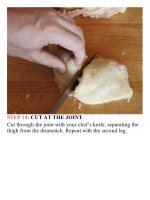The food lab better home cooking through science ( PDFDrive ) 121
Bạn đang xem bản rút gọn của tài liệu. Xem và tải ngay bản đầy đủ của tài liệu tại đây (117.47 KB, 2 trang )
atouchoflemonjuice.Itshouldflowslowlyoffaspoonso
thatitnapsapoachedegginathickrobe.Neverrunny,and
certainly never curdled, hollandaise has a delicate texture
that’s really tough to get right.At least, it used to be. I’ve
figured out a way to make it perfectly every single time—
evenwithnoexperience.
Hollandaise sauce, just like mayonnaise, is an eggstabilized emulsion of fat in a water-based liquid (see
“Obsessive-Emulsive,”here). It’s traditionally made by
cooking egg yolks with a little water, whisking them
constantly, until they’ve just begun to set, then slowly
drizzling in melted clarified butter (see “Clarified Butter,”
here) and seasoning the sauce with lemon juice. With
vigorous whisking, the butterfat gets broken up into
microscopicdropletsthataresurroundedbythewaterfrom
the lemon juice and the egg yolks. Both the acid in the
lemonjuiceandtheproteinlecithinintheeggyolksprevent
thesefatdropletsfromcoalescingandbreakingdownintoa
greasypool.Theresultisathick,creamy,delicioussauce.
Mayonnaise is relatively simple: it’s made from a liquid
fat (oil), and it’s made and kept at room or fridge
temperatures (for a foolproof recipe, seehere). Hollandaise
is more complicated. Butterfat begins to solidify below
95°F, so if you let your hollandaise get too cool, the solid
chunks of fat will break the emulsion, turning it grainy.
Reheatit,anditwillseparateintoagreasyliquid(that’swhy
leftover hollandaise can’t be stored). On the other hand, if
you let it get too hot, the egg proteins will begin to
coagulate.You’ll end up with a lumpy, curdled sauce with
the texture of soft scrambled eggs. So the keys to a perfect
hollandaisearetwo:carefulconstructionofanemulsionby
slowly incorporating butterfat into the liquid, and
temperaturecontrol.
Once you realize this, the solution to foolproofing
hollandaise becomes quite simple. Most classic recipes
require you to heat both the butter and egg yolks before
tryingtocombinethetwo.Butwhatifyouweretojustheat
oneofthem,sothatwhenitiscombinedwiththeother,the
finaltemperatureendsupinthecorrectrange?Ifiguredthat
ifIheatedmybuttertoahigh-enoughtemperature,Ishould
be able to slowly incorporate it into a mixture of raw egg
yolks and lemon juice, gradually raising its temperature, so
that by the time all the butter is incorporated, the yolks are
cookedexactlyhowtheyneedtobe.Becausetheacidityof
lemon juice can minimize curdling, there’s a little bit of
leewayasfarastemperatureisconcerned:anywhereinthe
160°to180°Frangeforthefinishedsaucewillwork.









